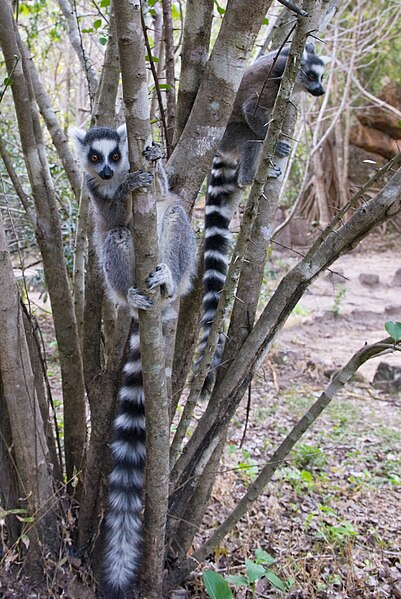Author's Note: This is my 100th blog post!!! A special thanks to all of you devoted readers out there!
Yes, Father's Day will be here
once again! Just like what we did with Mother's Day this and last
year, we're going to devote this blog post to father's all over the
world! That's not the only thing we're celebrating: tomorrow marks my blog's 2nd year anniversary! I'm so excited! Two years of writing this blog . . . where has the time gone? Perhaps this makes today the perfect day to talk about some really cool news concerning, you guessed it,
Jurassic World, the upcoming movie. Let's get started.
Days Till
It is: 3 days till Father's Day
It is: 9 days till Summer Solstice and the first day of summer
It is: 22 days till Independence Day
In the Spotlight
A couple of months ago, some official images from Jurassic World were released. We now have three more to add to the collection:
 |
| Chris
Pratt's character, Owen, appears to use a motercycle to get around the
park. If the raptors escape, this vehicle will come in handy! |
 |
| Bryce Dallas Howard's character appears to be having a conversation with Owen in this photo, the topic is unknown. |
 |
| I
don't know about you, but this picture appears to be from a scene in
which Ty Simpkin's (right) and Nick Robinson's character (left) appear
to have come across a dangerous situation! |
Of course, exactly what's happening in the scenes these photographs come from is unknown, but I can't wait to see when the movie finally roars into theaters exactly one year from now, on June 12, 2015!!! Only 365 days to go . . . just don't count down for me!
Topic of the Week by
Christian Ryan
Mother's often get a lot of credit, both human mothers and mothers of
the natural world. Not that they're not due the credit! I mean,
without mothers, the world would be a very different place, as
mothers do a lot of things in our lives that no one else could do
(giving us life is one example). So the purpose of this article is
not to bash the attention mother's get. However, father's are also
important in the role of any animal or person's life. Without them,
we still wouldn't be born.
Scripture
perfectly illustrates the importance of father's in the human
household. In Ephesians 6:2, the writer Paul says, “Fathers,...bring
them (their children)
up in training and instruction of the Lord.”
Another verse says that father's should “Train
up a child in the way he shall go, so that when he is old, he shall
not depart from it,” Proverbs 22:6.
Perhaps father's in nature don't get a lot of credit of child-rearing
sometimes because, frankly, most male animals simply mate with a
female and move on to find another mate. But there are a few animal
father's that not only stick around after mating, but they also help
take care of their offspring. So today, let's look at some of the top
animal dads!
Ostrich
 |
| A father ostrich feeds with one of his chicks. |
Something special happens when an ostrich gets between 2-4 years of
age: they're ready to mate! At that age, most humans are only just
learning to walk and talk! When it comes time to find a mate, the
male ostrich performs a special mating dance with his wings – by
creating alternating wing beats, he hopes that a female will find him
attractive enough to be his mate. Once mating is done, it becomes
time for egg-laying. Unlike many species of birds, ostriches make
communal nests, meaning more than one female ostrich will lay their
eggs in a single nest. The nest is dug out by the male and is 1-2
feet deep and almost ten feet wide! The dominant female gets the
first dibs on laying eggs and it is only after she's finished that
other subordinate female ostriches will lay their eggs. When the
other females are finished laying, the dominant female often kicks
out some of the eggs of other females, leaving about 20 eggs in the
nest, including her own. Then it's time for the incubating process.
For the next 35 to 45 days, the parents alternate incubating the nest
of eggs. Typically, the dad will incubate the eggs at night because
his black-colored feathers make him harder to see in the dark; the
mother on the other hand incubates normally in the daytime because
her feathers are a lighter color and blend in with sand and savanna,
scrub, and/or desert foliage. Even after the eggs hatch, the male
continues to stick around. Though the mother helps out, it is mostly
the father's responsibility for defending the young and teaching them
to feed. A close relative of the ostrich, the male rhea, rears its young in almost the same way, but with pretty much no help from the female.
Lion
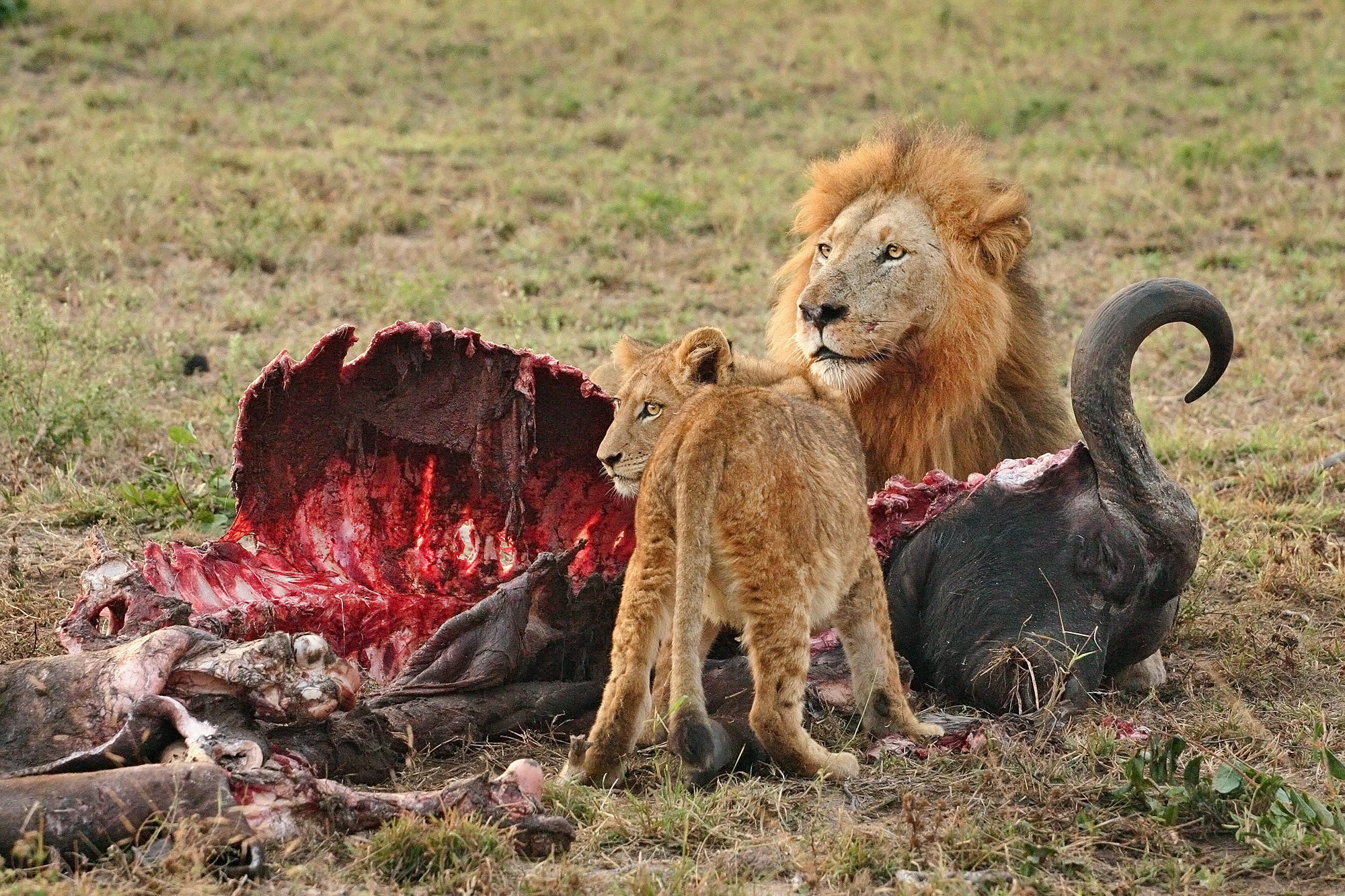 |
| Male lions will ferociously protect their families from all intruders. |
The male lion may look majestic and is often referred to as “The
King of the Beasts”. However, it turns out that they don't do too
much in life. Once taking over a pride, they metaphorically hit the
couch; though they do sometimes help the rest of the pride hunt, they
mostly let the lionesses do the work. Then, as if that wasn't bad
enough, he claims first dibs to the kill! So how on earth did the
lion get onto our list of “best animal dads”? Perhaps an even
better question is why on earth the lionesses even need him around?
Well, as you may or may not already know, male lions are responsible
for protecting the pride from other male lions. Sometimes, other
males will attempt to take over the pride; this is when the male lion
really shows why he's “King of the Beasts” (though
technically, I maintain this title belongs to the elephant since
they're much larger and stronger)! A pride leader knows that if
another male takes over the pride, he will kill all the cubs under
the age of two; this enables the lionesses to come into heat again.
The pride leader uses all his muscle and strength to make sure that
he remains leader of the pride. Despite their apparent laziness, it's
never wise to underestimate the power of a male lion! Though a fierce
fighter and often somewhat rough on lionesses (especially during
mating), lion dads can be quite tolerant of their kids. Often times,
they will allow them to play with their father's tail or his majestic
mane. Now you know why the male lion rightly deserves a spot on our
list!
Gorilla
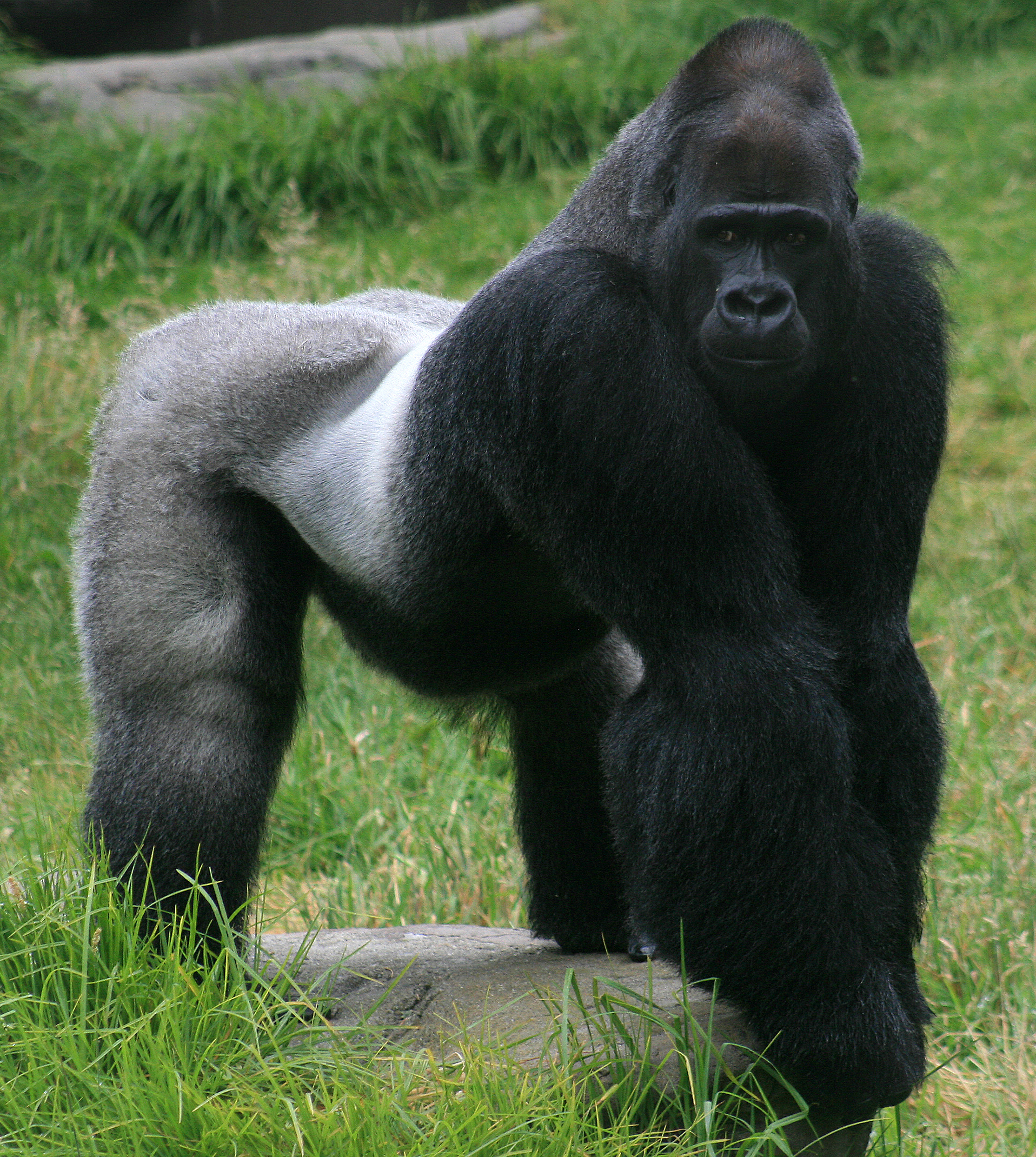 |
| The dominant silverback gorilla is one of the most protective dads in the animal kingdom! |
There are four subspecies of gorilla within the two species of this
ape: the Western lowland gorilla (with the easy-to-pronounce
scientific name of Gorilla gorilla gorilla), the Cross River
gorilla, the Mountain gorilla and the Eastern lowland gorilla.
Gorillas live in groups known as troops, normally consisting of an
alpha male – adult male gorillas are called silverbacks due to the
silver-colored fur on their backs – adult females and their young,
though sometimes other adult males may be present in the group.
Gorilla troops center around the silverback alpha. He gets all the
mating rights to the females in his troop if other males are present
in the troop and he's responsible for leading the group to feeding
sites, choosing where they'll go, making all the decisions and
stopping conflicts between other members of the troop. Another job of
the alpha silverback gorilla is to keep the troop safe from predators
and rival silverbacks. The silverback gorilla is one of the best
dad's in the animal kingdom because they will fight with their lives
at stake in order to protect their families. Predators such as
leopards are a potential threat to a troop of gorillas. When
threatened with rivals, gorillas will often do the characteristic
chest-pounding behavior in an attempt to drive them off. Despite
being a strong and powerful creature, silverbacks are pretty laid
back animals and prefer to live peaceful lives in the Africa
rainforests they call home.
Phalarope
 |
| The phalarope is one of the few bird species in the animal kingdom in which the dads have duller plumage than females and presume the role of raising the children solo. |
Also known as the wadepiper, this bird is a shorebird with a slender
neck that often feeds in multitudes in areas such as the Great Salt
Lake in Utah and the Mono Lake in California. In most animal species,
the male is more brilliantly colored than the female and it's the
female's job to care for the young. But no one told that to the
phalarope! Not only are females more colorful than potential mates,
but they are also one of the few animal species in which the females
try to search out and fight over males! In fact, the phalarope sexes
basically have switched roles when it comes to reproduction. During
the mating season, female phalarope will mate with a number of
different males before laying their eggs and leaving the area to
migrate south, freeing themselves of child-rearing responsibilities.
The job of incubating the eggs and caring for the young belongs
completely to the dads! This Father's Day, spare a thought for the
hard-working phalarope, because these dads definitely have their
hands (er, wings?) full!
Great
Hornbill
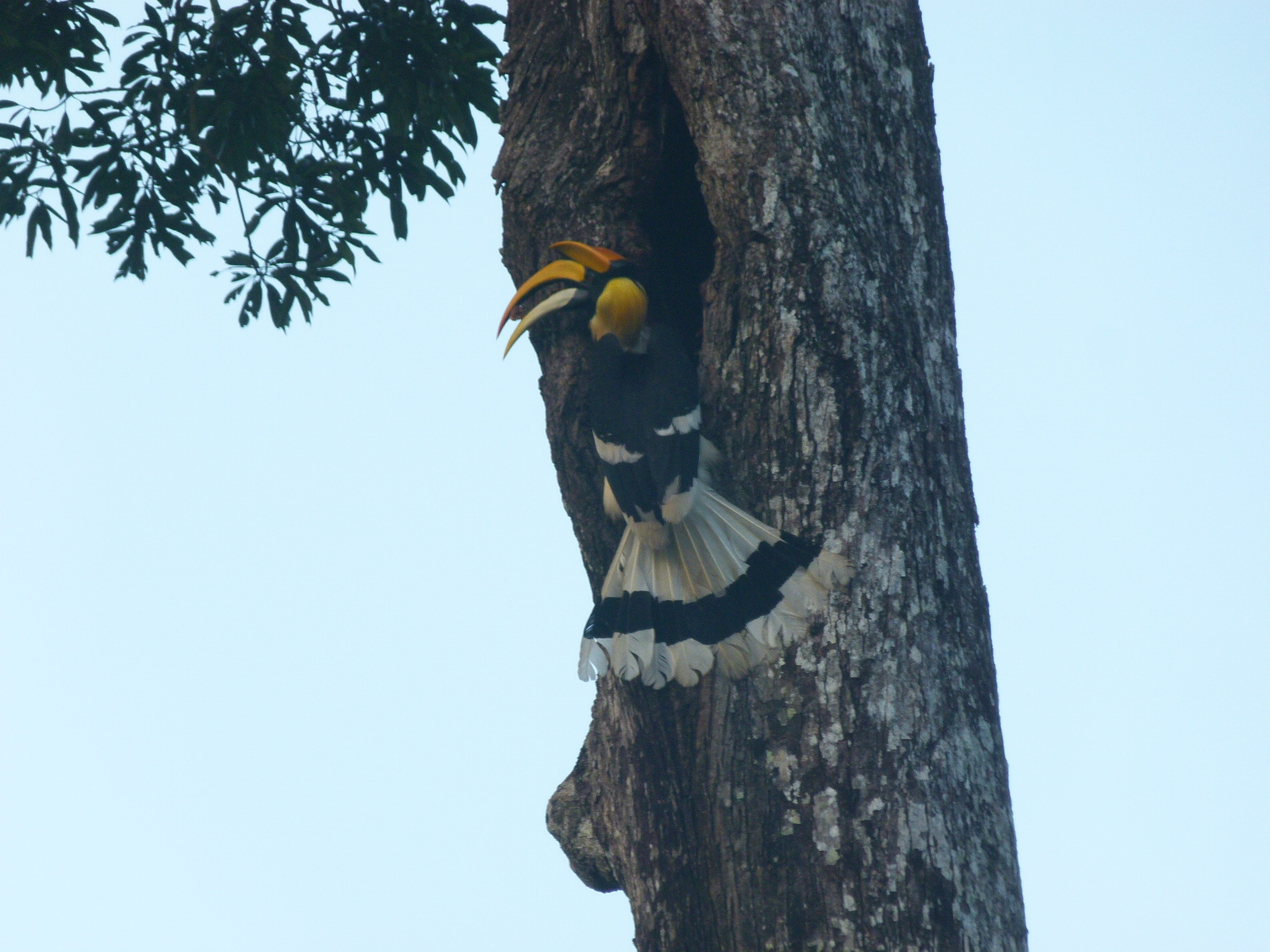 |
| This great hornbill dad has just returned to the nest hole with food to feed his mate, who is trapped inside. |
There are many species of hornbills, but the one we'll be focusing on
is the species known as the great hornbill, also known as the great
Indian hornbill. Most species of hornbills are monogamous breeders,
and the great hornbill is no exception. When it comes time to lay
eggs, the female will find a hollow in the trunk of a large tree,
either one made naturally or by a woodpecker; they are often used
more than once by the hornbill pair. Before going into the tree
cavity, the female (sometimes helped by her mate) begins to seal the
entrance with a little fruit pulp and mud, but the primary thing she
uses is droppings, leaving a hole just big enough for her to squeeze
through. Then she'll close the hole up some more, blocking herself
in, save an even smaller hole. They do this to ensure a higher rate
of survival for their chicks. Once inside, the female lays two to
eight eggs (the exact number varies with each species). But because
she's sealed herself in, the mother hornbill can't get out to feed
herself or her young once they hatch. This is why the hornbill father
is one of the best animal dads – while the young are incubating in
their eggs, the father flies to and from the nest, delivering food to
feed his mate and, and later his children. What's on the great
hornbill's menu? How about fruit, insects and small animals? Sound
yummy? After the eggs hatch (which takes 38-40 days) and the chicks
grow a certain size, you can imagine that it might be a bit cramped
inside the nest. This is when the mother breaks out of the nest; in
some species, the mother rebuilds the wall, while in others, the
young do this job. As the young mature, both hornbill parents
continue to feed and care for their young ones. Sounds like the
hornbill dad has a lot of work cut out for him!
Three-Spined
Stickleback
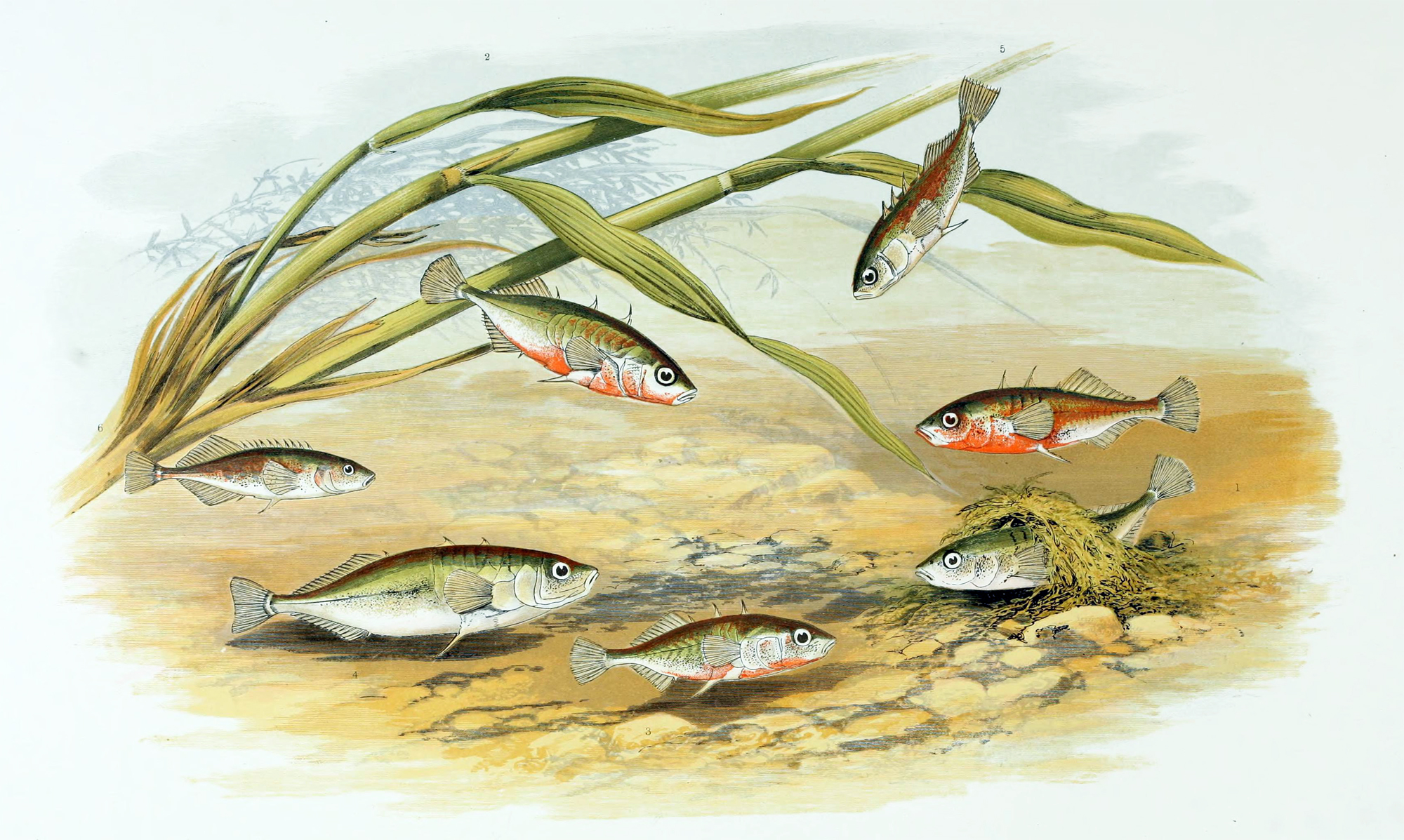 |
| In this illustration, the male Three-spined Stickleback fish (bottom right) builds a nest and tries to attract females nearby. |
Most fish could care less as to what happens to their eggs after
their laid. But the 2-inch-long three-spined stickleback is one of
the most unique dads in the fish world. They usually can be found in
coastal waters or freshwater bodies that connect in someway or
another to the coast in the Northern Hemisphere. In late April and
July, both genders of this species leave the deeper waters and head
inland into areas more shallow. This is where male sticklebacks dig
out a small depression and creates a nest made up of plant material,
sand and various types of debris all glued together with a special
substance from his kidneys called spiggin. After the nest is glued
together, he'll make a tunnel in it and attempts to lure females
nearby with a dance that involves zigzag movements. If the female is
impressed, she'll follow the male to his nest and lay 40-300 eggs!
Then it comes time for the male to fertilize the eggs. Other than
actually laying the eggs, female sticklebacks play no role in the
child-rearing process; but you can't really blame her for leaving the
eggs to the male, because he's the one that chases her away from the
area! Apparently, the male stickleback likes being a single parent.
The eggs take about 7-10 days at 18-20 degrees Centigrade and during
that time, the male fans them with his fins to make sure they get
plenty of fresh oxygen-loaded water. He also chases away other
sticklebacks, no matter what sex (however, he will try to attract
gravid females to add their eggs to his nest). When the baby
sticklebacks hatch, the father tries desperately to keep them with
him by grabbing any that exit the nest into his mouth and dumping
them back into the nest. Eventually though, the young are able to get
away from where they hatched. For the dad however, it's time to
either leave the nest or repair it to attract more females!
Emperor
Penguin
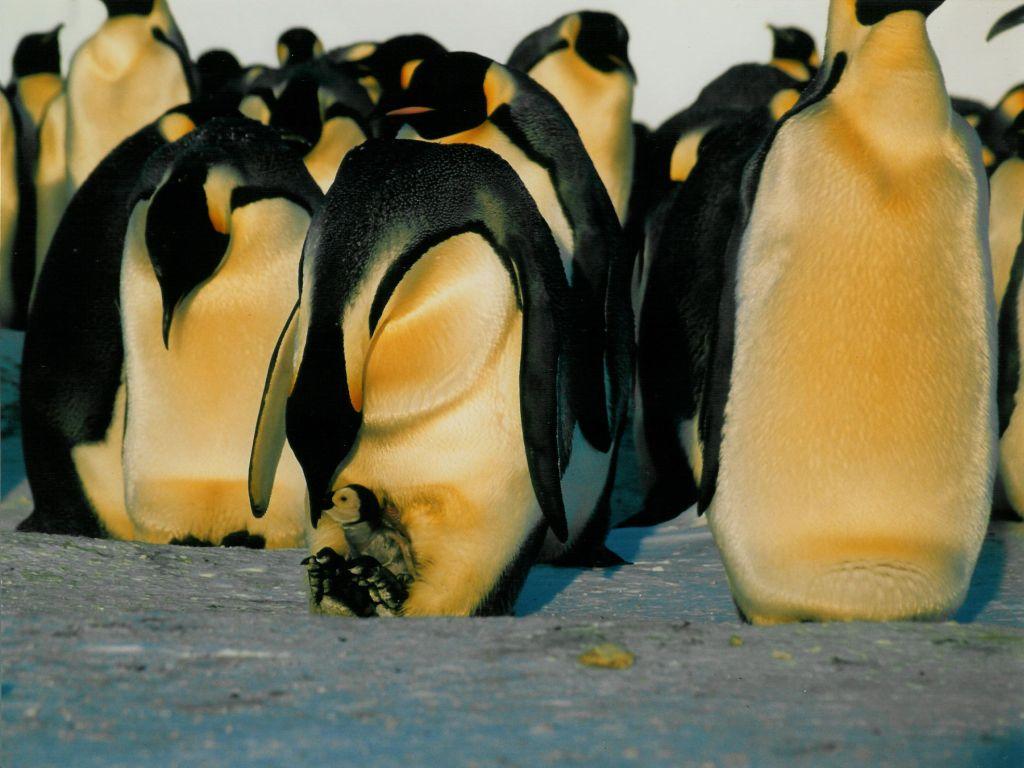 |
| During the long, cold months the father emperor penguin balances his offspring on his feet while waiting for his mate to return, he feeds the baby a milk-like substance to keep it from starving. |
Perhaps the emperor penguin of the coldest continent on the planet –
Antarctica – should be nominated as most devoted father of the
year! After reaching the age of three, the emperor penguin is old
enough to join in the yearly ritual of reproducing. Every year,
thousands and thousands of adult birds form a colony and march to
yearly nesting sites 31-75 miles inland so that they may lay their
eggs where the pack ice is nice and thick. This alone is an amazing
feat considering penguins have short, almost non-existent legs. This
species of penguin is monogamous, kind of like the great hornbill,
and after the female lays a single egg about a pound in weight in May
or early June, her nutritional reserves will be so exhausted that
she'll have to return to the ocean to feed . . . for two whole
months! While she's gone, it is the father's duty to protect the egg
from the elements. For 64 consecutive days before the egg hatches,
the father penguin carries the precious egg atop his feet and
underneath a special brooding pouch, all while battling the fierce
Antarctic winter that possesses terrible storms and winds that blow
120 mph! To protect themselves from the cold, emperor penguin fathers
will all huddle together and take turns huddling in the middle of the
group. The time between traveling to the nesting grounds, mating and
incubating the egg is four months, and during this time an emperor
penguin father can loose up to 44 pounds; that's half of his body
weight! Finally, the egg hatches and if the mother has yet to return
from the sea, the father will feed the newborn a special milk-like
liquid from his throat. It isn't until mid-July to early August that
the mother emperor penguins return to their mates and hatchlings to
relieve the father off his duties so that he can make a short trip to
the sea to get something to eat. Talk about pure devotion!
Sea
Horse
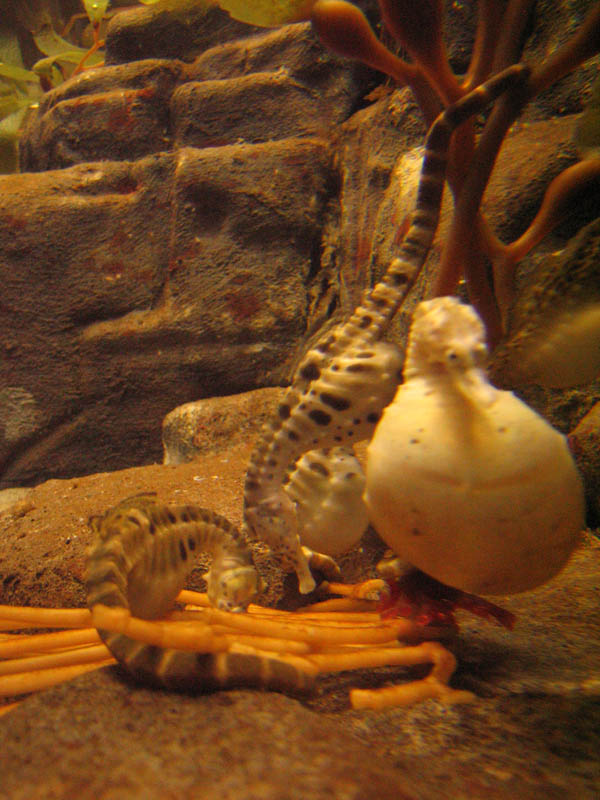 |
| Stuffed full of offspring, the father sea horse (far right) is probably the strangest father in the animal kingdom! |
If you think the way your
parents raised you was a bit strange now, your mind might change
drastically after reading about the strangest dad in the animal
kingdom. Sea horses aren't only weird in appearance, but the way they
reproduce is just plain bizarre! When most animals court during the
mating season, it doesn't take too long. Sea horses however often
court for several days before the “official courtship dance”
which lasts eight hours. Then it's time for them to mate. Why is the
sea horse the animal kingdom's strangest dad? Well, after the
courtship dance is complete, the sea horse female will insert her
ovipositor into her mate's brooding pouch, injecting anywhere between
dozens and thousands of eggs. So she isn't even the individual who
gets pregnant – the father does! Inside his pouch, the male sea
horse produces prolactin to keep the developing eggs healthy;
prolactin is the same hormone that causes milk production in mammals,
including humans! However, unlike the sticklebacks and phalarope we
already learned about, the female doesn't abandon the male after
giving him the eggs. Instead, she'll visit him every morning for
roughly six minutes to reminiscent of their courtship. Then it's time
for the young to be born and this extraordinary dad . . . actually
gives birth! Most sea horse dads give birth to 100-1,000 baby sea
horses. From then on, the babies must fend for themselves and receive
no extra parental care; in fact, the sea horse dad will be ready for
his mate to give him more eggs to bear upon her return and the
process will begin again. Talk about a strange upbringing!
So there you have it, the
best animal dads, just in time for Father's Day! We've looked at some
of the most devoted fathers, fathers that do all the work of
child-rearing, fathers that pair up with their mates, fathers that
protect their families from danger and even a father who gets
pregnant and gives birth! While we continue to learn more about these
and other incredible dads in nature, they should also remind us of
just how much our Heavenly Father and our human dads care and love
us!
If you liked this article, please be sure to subscribe to my blog, tell your friends about it and to all the fathers of the
world: HAVE A HAPPY FATHER'S DAY!!!
P.S. 1: Have a puzzling
question about animals (including dinosaurs), myself, my latest book,
my stop-motion movies, Creation or etc? Please post your question as
a comment or send me an email at
animaladventures@aol.com.
PS. and/or at animaladventures1314.blogspot.com, as
sometimes messages don't come in via my AOL account.
P.S. 2: Many (or in some
cases all) of the photographs and images above are not mine. If you
own one or more of them and would like them to be removed, politely
let me know via one or both of the email addresses above.
P.S. 3: What’s the new in
the news? Check it out at
SMILEY’S
NEWS.























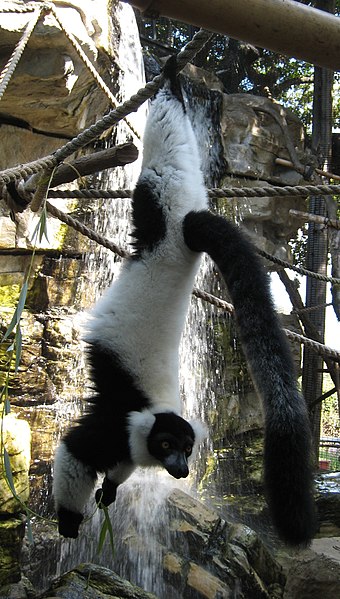
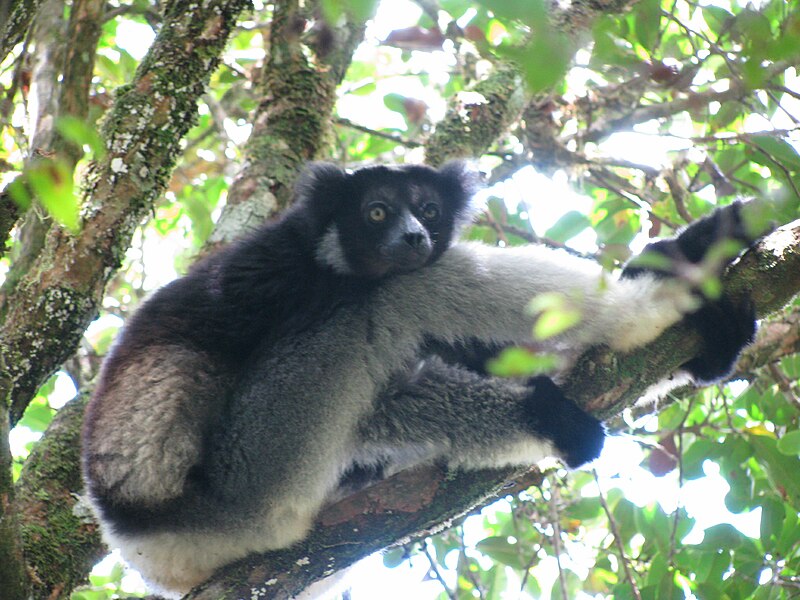
_2.jpg)


